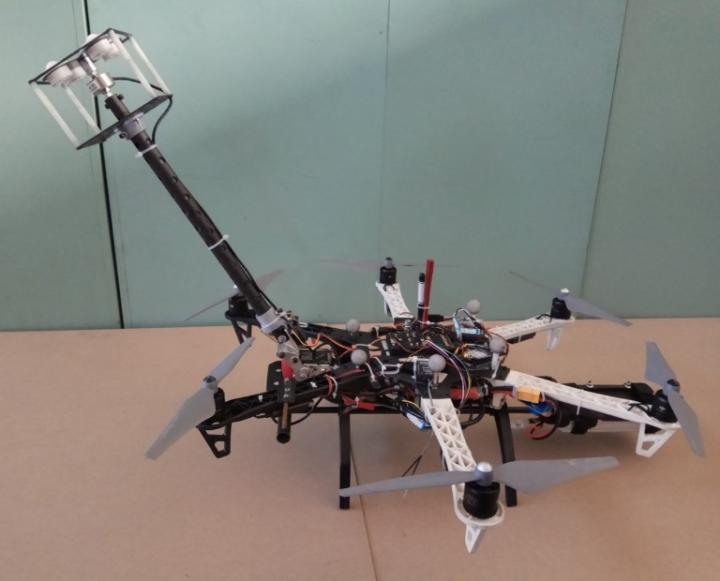A 'worker' that flies: Chinese researchers design novel flying robot

The contact aerial manipulator system Image by MENG Xiangdong
No, but Chinese researchers at the Shenyang Institute of Automation (SIA) of the Chinese Academy of Sciences have designed a promising alternative.
Recently, they reported the development of a contact aerial manipulator system that shows high flexibility and strong mission adaptability. They presented their findings at the 2019 IEEE/RSJ International Conference on Intelligent Robots and Systems (IROS 2019), an international conference on robotics and intelligent systems held from Nov. 4-8 in Macao.
Traditionally, regular inspection of high-rise buildings with glass curtain walls has been conducted by humans with gondola systems, which can be very dangerous, costly and inefficient.
The new robot represents a major advance in safety and efficiency. It comprises a single-degree-of-freedom manipulator cube-frame end effector and a hex-rotor UAV system.
Compared with general wall-climbing robots, it is capable of avoiding obstacles and even jumping over grooves on wall surfaces. It can also conduct interactive operations while in flight. Importantly, it has been designed so that the whole system's contact force can be controlled precisely without any force sensors.
“How to control the force is considered the most difficult problem, since flying robots usually are sensitive to external force,” said MENG Xiangdong, the robot's designer.
MENG said realizing this objective required first making a flying robot with closed loop control behave like a regular spring system. He said that the elastic coefficient could then be easily changed by altering the control parameters. “It means that we can take the robot as a spring system so that the contact process can be safe enough,” said MENG.
The research team also conducted experiments to test the system. For example, the researchers fixed a light switch to a wall, then had the robot press the switch to turn the light on and off. The robot was able to safely and smoothly operate the switch via precise force control. In another experiment, the robot smoothly moved along a glass wall, exerting fixed pressure. The robot then used a pen attached to the end of the aerial manipulator to write “SIA” – for Shenyang Institute of Automation – on the glass wall.
“In the near future, we might see an extensive use of this new system in large infrastructure maintenance, and other special applications, such as scientific sampling.” said MENG.
Media Contact
More Information:
http://english.cas.cn/All latest news from the category: Information Technology
Here you can find a summary of innovations in the fields of information and data processing and up-to-date developments on IT equipment and hardware.
This area covers topics such as IT services, IT architectures, IT management and telecommunications.
Newest articles

NASA: Mystery of life’s handedness deepens
The mystery of why life uses molecules with specific orientations has deepened with a NASA-funded discovery that RNA — a key molecule thought to have potentially held the instructions for…

What are the effects of historic lithium mining on water quality?
Study reveals low levels of common contaminants but high levels of other elements in waters associated with an abandoned lithium mine. Lithium ore and mining waste from a historic lithium…

Quantum-inspired design boosts efficiency of heat-to-electricity conversion
Rice engineers take unconventional route to improving thermophotovoltaic systems. Researchers at Rice University have found a new way to improve a key element of thermophotovoltaic (TPV) systems, which convert heat…



